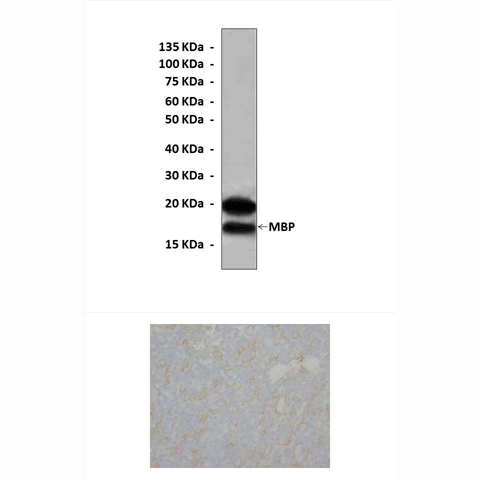Product Sheet CA1050
Description
BACKGROUND The myelin sheath is a multi-layered membrane, unique to the nervous system that functions as an insulator to greatly increase the velocity of axonal impulse conduction. Myelin basic protein (MBP) is one of the specific proteins of the central nervous system (CNS) and may function to maintain the correct structure of myelin, interacting with the lipids in the myelin membrane by electrostatic and hydrophobic interactions. MBP’s central role is to maintain the structural integrity of the myelin sheath, by holding together the apposing cytoplasmic leaflets of the oligodendrocyte membrane in a tight, spiral, multilamellar arrangement. The gene for the MBP is expressed by oligodendrocytes and Schwann cells, and it represents 30% of the protein component of myelin. In mammals various forms of MBP exist which are produced by the alternative splicing of a single gene; these forms differ by the presence or the absence of short (10 to 20 residues) peptides in various internal locations in the sequence. The major form of MBP is generally a protein of about 18.5 kDa (170 residues). MBP is the target of many post-translational modifications: it is N-terminally acetylated, methylated on an arginine residue, phosphorylated by various serine/threonine protein-kinases, and deamidated on some glutamine residues.1 MBP’s extreme physicochemical properties, net charge of +19 at neutral pH, low proportion of hydrophobic residues, alternating regions of predicted intrinsic disorder and order, induced folding upon association with membranes and other proteins, and diversification via combinatorial post-translational modifications, define not only its role as a molecular Velcro in compact myelin, but as a multifunctional hub that may also bind to a number of other proteins and small molecule ligands in myelinating oligodendrocytes. In particular, MBP may link the underlying cytoskeleton and proteins containing SH3 domains to the membrane, allowing it to transduce transmembrane signals to the cytosol. These associations are facilitated by MBP being an intrinsically disordered protein, creating a large effective protein surface, and by the formation of transient and/or induced ordered secondary structure elements for molecular recognition. These processes can be modulated by a molecular barcode of numerous post-translational modifications and interactions with proteins such as calmodulin. In the human demyelinating disease multiple sclerosis, an aberrant pattern of modifications may contribute to demyelination and confound inherent attempts at repair. The conformational dynamics of the various isoforms and modified variants of MBP and their interactions with other proteins potentially allow them to participate in events coupling extracellular signals to cytoskeletal organization during myelination or remyelination.2
Studies using knockout mice have demonstrated severe neurological deficits such as seizures, tremors and an early death when MBP is lacking. The demyelination disease, Multiple Sclerosis, is an example of a human disease that involves the selective loss of MBP by autoimmune mechanisms. Individuals afflicted with MS develop a compromised neurological condition. Moreover, when there is damage of the CNS, MBP or its peptides, which represent an important part of the myelin, can appear in the cerebrospinal fluid (CSF), blood and urine. Thus, MBP or myelin basic protein-like material (MBPLM) levels in the CSF could be a marker of the damage of the myelin.2 In addition MBP-related transcripts are also present in the bone marrow and the immune system.3
Studies using knockout mice have demonstrated severe neurological deficits such as seizures, tremors and an early death when MBP is lacking. The demyelination disease, Multiple Sclerosis, is an example of a human disease that involves the selective loss of MBP by autoimmune mechanisms. Individuals afflicted with MS develop a compromised neurological condition. Moreover, when there is damage of the CNS, MBP or its peptides, which represent an important part of the myelin, can appear in the cerebrospinal fluid (CSF), blood and urine. Thus, MBP or myelin basic protein-like material (MBPLM) levels in the CSF could be a marker of the damage of the myelin.2 In addition MBP-related transcripts are also present in the bone marrow and the immune system.3
REFERENCES
1. Boggs, J.M.: Cell. Mol. Life Sci. 63:1945-61, 2006
2. Harauz G. et al: Biochem. 48:8094-104, 2009
3. Beniac, D.R. et al: J. Biol. Chem.. 272:4261-8, 1997
2. Harauz G. et al: Biochem. 48:8094-104, 2009
3. Beniac, D.R. et al: J. Biol. Chem.. 272:4261-8, 1997
Products are for research use only. They are not intended for human, animal, or diagnostic applications.
Details
Cat.No.: | CA1050 |
Antigen: | Short peptide from human MBP sequence. |
Isotype: | Rabbit IgG |
Species & predicted species cross- reactivity ( ): | Human, Rat |
Applications & Suggested starting dilutions:* | WB 1:1000 IP n/d IHC 1:50 - 1:200 ICC n/d FACS n/d |
Predicted Molecular Weight of protein: | 18.5-20 kDa |
Specificity/Sensitivity: | Detects endogenous levels of MBP proteins without cross-reactivity with other family members. |
Storage: | Store at -20°C, 4°C for frequent use. Avoid repeated freeze-thaw cycles. |
*Optimal working dilutions must be determined by end user.
Products
| Product | Size | CAT.# | Price | Quantity |
|---|---|---|---|---|
| Rabbit MBP Antibody: Rabbit MBP Antibody | Size: 100 ul | CAT.#: CA1050 | Price: $375.00 |

